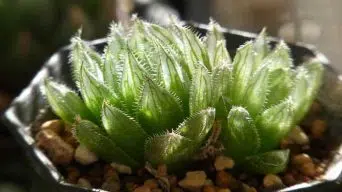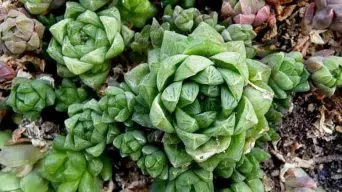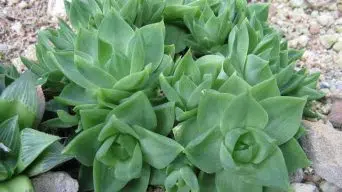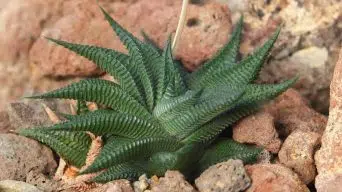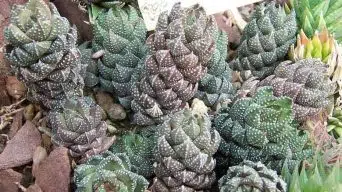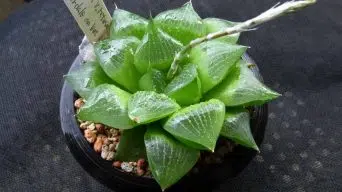With their distinctive appearance and ease of propagation, Haworthia emelyae plants are perfect for any type of garden.
The Haworthia genus has many species, but Haworthia emelyae is one of the most popular because it’s easy to care for and propagate.
This article will teach you everything you need to know about caring for Haworthia emelyae plants and how to grow and propagate them yourself!
Overview
Haworthia emelyae is a small succulent plant of the Haworthia genus in the family Asphodelaceae, native to Western Cape, South Africa.
The Haworthia emelyae, also known as Haworthia picta, is a slow-growing succulent that forms rosettes of triangular, fleshy leaves.
This attractive Haworthia plant features stemless rosettes that will grow up to 4 inches (10 cm) in diameter. Its leaves are green to brown with white to pink markings.
The flowers are white with green veins and appear on upright stems, up to 16 inches tall (40 cm).
How To Care for Haworthia Emelyae
Haworthia emelyae care is simple but not easy. This means that the plant is easy to care for, but requires some work.
Below you will find a summary of how to care for and propagate the Haworthia emelyae succulent plant.
Sun Exposure & Light Requirements
Haworthia emelyae succulents require full sun to partial shade.
In general, this succulent needs between six to eight hours of sunlight per day for optimum health.
A Haworthia emelyae succulent exposed to lower levels of sunlight will grow slower. Still, it should not be deprived of light altogether.
It can thrive in shady areas with filtered or indirect sun exposure as long as it receives some amount of light each day.
Haworthia emelyae plants thrive best outdoors in a sunny location.
The succulent can also be grown as an indoor plant if provided the proper amount of light and care.
Haworthia emelyae will require more direct sunlight than other plants during their first year. Still, they gradually become accustomed to lower amounts of light as time goes on.
Watering Requirements
Haworthias don’t like having their roots sitting in a water pool, which is especially important with Haworthia emelyae.
The soil should be allowed to dry out entirely before watering again.
When the plant does receive water, it’s best to give just enough for the top inch or two of soil to become wet.
In general, Haworthia emelyae should be watered once every week or two.
Haworthias are relatively drought-tolerant plants, but they appreciate a good drink here and there to keep them happy.
Soil Requirements
Haworthia emelyae is a succulent plant with soil requirements that are very specific to its species.
The substrate should not be too loose or compacted, which may cause the roots of the Haworthias to rot or suffocate.
It needs well-drained soils and prefers gravel, coarse sand, pumice stone, red rocks (i.e., lava), and volcanic cinders for drainage purposes.
To ensure good root growth in porous media such as these materials, it’s important to use potting mix made from organic material like peat moss mixed with perlite.
This will promote aeration without compromising moisture retention abilities.
A cactus potting mix is another good option to use, which should be supplemented with sand or lava rock.
Temperature and Humidity
Haworthia emelyae is a succulent plant which means it enjoys warmer temperatures.
It will need to be kept in an area with plenty of sunlight that has dry air.
The temperature should never exceed 32 degrees Celsius (89.6°F) and ideally stays at around 22-25 degrees Celsius (71.6-77°F) during the day and 18-20 degrees Celsius (64.4- 68°F) at night time.
If your Haworthia succulent starts dropping its leaves, turn down the heat!
Fertilizing
Haworthia emelyae plants don’t require much fertilizer, so fertilizing them is typically unnecessary.
If your plant is looking a little limp and unhealthy, it may be time to fertilize.
This can be done with either water-soluble or organic slow-release fertilizer.
It’s important not to overdo this process because too much of the wrong type of fertilizer can do more harm than good for your plant.
In the world of succulent plants, fertilizer is typically not necessary.
If you want to fertilize your plant anyway, a good rule of thumb is that it should be one tablespoon for every four inches of potting soil present in the planter/container.
This can also be applied as “one teaspoon per container” or “two teaspoons for every six inches.”
Do not use any more than what’s recommended because too much will leave residue on leaves and eventually kill them.
Potting and Repotting
When potting your Haworthia emelyae for the first time or when it is root bound in its current container, choose an appropriate container with drainage holes at the bottom.
Mixing the soil with sand can provide additional aeration during watering periods while also reducing excessive moisture retention.
Your succulent should be potted into only one inch (two centimeters) worth of soil since these plants do not require deep pots to grow.
It should be potted at the same level it was previously growing in its old container.
Pot your succulent after the soil has been thoroughly soaked but before it is time for watering again.
If you are not sure when to repot an established succulent, wait until its leaves begin to droop under their own weight.
Repotting should happen every two years with a maximum depth of one inch per year.
This will help avoid excessive water retention and prevent root rot from occurring due to overcrowding at the top layer of soil.
Make sure that there is little space left between individual plants because they will grow larger as new shoots develop.
This may cause others to be crowded out if too much time passes without being separated into different containers.
Pruning
Haworthia emelyae plants don’t need to be pruned.
However, if you feel the plant has too many leaves and is not compact enough, you can trim off some of its leaf tips.
If the leaves are too large, you can also trim them to make them look nicer.
If your plant has dead growth and you want to keep more compact plants, then you should prune off these parts completely.
When they grow older, you will notice that some Haworthia emelyae plants tend to grow taller and spindlier.
Pests and Diseases
Pests and diseases can be a problem for any plant. Still, the Haworthia emelyae is particularly susceptible to problems with pests.
Spider mites are often found on succulents, including this one.
They are too small to see without magnification, so watch your plants closely every day. Some signs of infestation are webs around them or white debris on all their leaves.
The other significant pest that’s problematic for these plants is the mealybug.
They also secrete sticky honeydew, which will coat everything below it in an unsightly way and allow nasty mold spores to form on surfaces nearby.
If you suspect either of these insects has taken up residence in your garden, it’s best to take action.
You should isolate the plant from any other ones you have so that if pests are found on one, they won’t be able to jump over and infect others.
Spray your plants with water daily to keep them as clean as possible.
There’s no need to use any harsh chemicals or pesticides.
If you find either of these pests, remove them, and their eggs with a cotton swab dipped in rubbing alcohol.
If the infestation is really bad, try introducing ladybugs into your garden, as they will eat both spider mites and mealybugs!
The other major problem that people often encounter is plant rot due to overwatering.
You’ll know this has happened if there are brown patches on the leaves, which may also be falling off from time to time – it looks like someone rubbed slimy mud all over its surface!
This will happen because too much water was given at once, so don’t give them more than twice what they normally need.
After the water is absorbed, it will dry out quickly, and all should be well again, with no need to worry about any other problems.
You can also help prevent plant rot by not watering for a few days if there’s been rain. This mimics natural conditions when plants are dormant or full of moisture from recent rainfall.
How to Care for Haworthia Emelyae in Winter
In the winter, Haworthia Emelyae needs a lot of light.
It also needs to be watered less frequently.
You should water your plants one time every week during the coldest months. You can do this if the top of the soil is dry and also if you can feel that there is no moisture down at least 2 inches below.
When the temperature is below 40 degrees Fahrenheit, moving your plants outside is not a good idea. This plant’s leaves can break, and the soil will likely dry out in cold weather.
It is also important for you to remember that this Haworthia species needs bright light and warmth during the winter months.
If necessary, you should place this succulent on top of a heat mat or under an incandescent bulb so they don’t get too cold and lose their beautiful coloration!
How To Propagate Haworthia Emelyae
The Haworthia emelyae can be propagated by offsets or leaf cuttings.
Offsets
The Haworthia emelyae offsets are small, leafless plants that grow on the mother plant.
The offset is a miniature version of the parent. It can be removed from the mother to become its own individual plant.
The mother can produce many offsets, and each one must be removed by hand.
The offset will need to be placed in a pot with soil that has been pre-moistened, amended (if necessary), and tamped down.
Each offset needs approximately one to three months before it will be ready for the next step in Haworthia propagation.
Once you are sure that each offset has a well-developed root system, plant into individual pots or containers with soil amended as needed.
Water until moisture drains out of the drainage holes on the bottom.
Leaf Cuttings
Leaf propagation is the most common way to propagate Haworthia emelyae succulent plants.
Propagating leaf cuttings is a simple process that can be done at any time during the year.
- Remove the leaves from the succulent plants.
- Allow the leaves to callous for several days.
- Place them in a moist container with potting soil, perlite, vermiculite, or sand for seeds.
- Keep the soil moist and place it in a warm location.
- Once they develop roots and new shoots, start to grow, plant them in small containers with soil.
It will take about two months for the new plants to grow.
Is the Haworthia Emelyae Toxic?
The Haworthia emelyae succulent plant is not toxic to humans and animals.
This succulent does have a sap that can irritate the skin and should be handled with care.
The sap may cause irritation by coming into contact with your skin or eyes, so always wash your hands thoroughly after handling the Haworthia emelyae.
Final Thoughts
The Haworthia emelyae succulent plant can be a great addition to any landscape or indoor garden.
These plants are extremely easy to care for and propagate, making them the perfect beginner’s plant!


